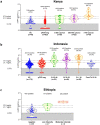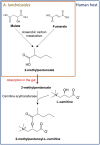2-Methyl-pentanoyl-carnitine (2-MPC): a urine biomarker for patent Ascaris lumbricoides infection
- PMID: 32978457
- PMCID: PMC7519643
- DOI: 10.1038/s41598-020-72804-y
2-Methyl-pentanoyl-carnitine (2-MPC): a urine biomarker for patent Ascaris lumbricoides infection
Abstract
Infections with intestinal worms, such as Ascaris lumbricoides, affect hundreds of millions of people in all tropical and subtropical regions of the world. Through large-scale deworming programs, World Health Organization aims to reduce moderate-to-heavy intensity infections below 1%. Current diagnosis and monitoring of these control programs are solely based on the detection of worm eggs in stool. Here we describe how metabolome analysis was used to identify the A. lumbricoides-specific urine biomarker 2-methyl pentanoyl carnitine (2-MPC). This biomarker was found to be 85.7% accurate in determining infection and 90.5% accurate in determining a moderate-to-heavy infection. Our results also demonstrate that there is a correlation between 2-MPC levels in urine and A. lumbricoides DNA detected in stool. Furthermore, the levels of 2-MPC in urine were shown to rapidly and strongly decrease upon administration of a standard treatment (single oral dose of 400 mg albendazole). In an Ascaris suum infection model in pigs, it was found that, although 2-MPC levels were much lower compared to humans, there was a significant association between urinary 2-MPC levels and both worm counts (p = 0.023) and the number of eggs per gram (epg) counts (p < 0.001). This report demonstrates that urinary 2-MPC can be considered an A. lumbricoides-specific biomarker that can be used to monitor infection intensity.
Conflict of interest statement
O.L., A.V., S.V.A., L.D., R.V., F.C. and L.J.S. are current employees of Janssen Pharmaceutica NV, and R.L. is current employee of Janssen Pharmaceuticals, Inc, both being Johnson and Johnson Companies and they may own stock or stock options in that company. The remaining co-authors have no conflicts of interest with the content of this article.
Figures







Similar articles
-
Detection of Ascaris lumbricoides infection by ABA-1 coproantigen ELISA.PLoS Negl Trop Dis. 2020 Oct 15;14(10):e0008807. doi: 10.1371/journal.pntd.0008807. eCollection 2020 Oct. PLoS Negl Trop Dis. 2020. PMID: 33057357 Free PMC article.
-
Distribution of Ascaris suum in experimentally and naturally infected pigs and comparison with Ascaris lumbricoides infections in humans.Parasitology. 1998 Dec;117 ( Pt 6):589-96. doi: 10.1017/s0031182098003382. Parasitology. 1998. PMID: 9881384
-
Development of allele-specific PCR methodology (AS-PCR) to screening A. lumbricoides and A. suum.Parasitol Res. 2022 Aug;121(8):2389-2397. doi: 10.1007/s00436-022-07572-x. Epub 2022 Jun 17. Parasitol Res. 2022. PMID: 35710846
-
Ascaris and ascariasis.Adv Parasitol. 2001;48:285-375. doi: 10.1016/s0065-308x(01)48008-0. Adv Parasitol. 2001. PMID: 11013758 Review.
-
Are Ascaris lumbricoides and Ascaris suum a single species?Parasit Vectors. 2012 Feb 20;5:42. doi: 10.1186/1756-3305-5-42. Parasit Vectors. 2012. PMID: 22348306 Free PMC article. Review.
Cited by
-
Immunomodulatory and biological properties of helminth-derived small molecules: Potential applications in diagnostics and therapeutics.Front Parasitol. 2022 Sep 9;1:984152. doi: 10.3389/fpara.2022.984152. eCollection 2022. Front Parasitol. 2022. PMID: 39816468 Free PMC article. Review.
-
The role of diagnostic technologies to measure progress toward WHO 2030 targets for soil-transmitted helminth control programs.PLoS Negl Trop Dis. 2021 Jun 3;15(6):e0009422. doi: 10.1371/journal.pntd.0009422. eCollection 2021 Jun. PLoS Negl Trop Dis. 2021. PMID: 34081694 Free PMC article. No abstract available.
-
Multimodal biomarker discovery for active Onchocerca volvulus infection.PLoS Negl Trop Dis. 2021 Nov 29;15(11):e0009999. doi: 10.1371/journal.pntd.0009999. eCollection 2021 Nov. PLoS Negl Trop Dis. 2021. PMID: 34843471 Free PMC article.
-
Metabolite Identification Using Infrared Ion Spectroscopy─Novel Biomarkers for Pyridoxine-Dependent Epilepsy.Anal Chem. 2021 Nov 23;93(46):15340-15348. doi: 10.1021/acs.analchem.1c02896. Epub 2021 Nov 10. Anal Chem. 2021. PMID: 34756024 Free PMC article.
-
Isomer-Specific Two-Color Double-Resonance IR2MS3 Ion Spectroscopy Using a Single Laser: Application in the Identification of Novel Psychoactive Substances.Anal Chem. 2021 Feb 2;93(4):2687-2693. doi: 10.1021/acs.analchem.0c05042. Epub 2021 Jan 20. Anal Chem. 2021. PMID: 33470107 Free PMC article.
References
-
- 2WHO. Soil-transmitted helminthiasis: Eliminating soil-transmitted helminthiasis as a public health problem in children. Progress report 2001–2010 and strategic plan 2011–2020 (2012).
-
- Katz N, Chaves A, Pellegrino J. A simple device for quantitative stool thick-smear technique in Schistosomiasis mansoni. Rev. Inst. Med. Trop. Sao Paulo. 1972;14:397–400. - PubMed
Publication types
MeSH terms
Substances
Grants and funding
LinkOut - more resources
Full Text Sources

